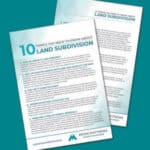Subdivision
We specialise in assisting property owners and developers with subdivisions - From start to finish
As a concept, subdivision is quite simple. You take a block of land and subdivide it into 2 or more lots. In practice, subdivisions can be complex, frustrating and expensive if you are not sure what you are doing.
The 3 most common subdivision mistakes we see are:
1. Buying a site that cannot be subdivided.
2. Not being clear on the true costs of subdivision.
3. Underestimating how long the process will take.
Each of these can be avoided by undertaking proper due diligence, having a system for site selection and checking with consultants experienced in the process.
Below we provide basic information on the subdivision process.
Check out our resources below to learn more about subdivisions.
What is the subdivision process?
Whether you are subdividing for the first time or you are an experienced developer, subdivisions all require the same process.
The following summarises the main stages of a simple code assessment subdivision.
Produce a subdivision proposal plan to Council lodgement standard.
Prepare the town planning report, code responses and all forms and other documents associated with the application package. This will include arranging preliminary civil engineering for the urban services required.
4) Lodge application and Council assessment
5) Decision
Once a decision is made Council will issue the approval. Every approval will include a number of conditions that must be complied with to complete the subdivision. Examples of conditions include installing water, sewer and roofwater, removing existing buildings and repairing kerb and gutter.
7) Plan Sealing
How much does subdivision cost?
The cost of a subdivision will vary depending on the size and number of lots and where you are developing.
In Brisbane, you should be budgeting approximately $130,000 for a simple 2-lot subdivision. This is the minimum you should be budgeting. The costs can be much higher depending on the site, what urban services are available and whether you are constructing driveways and stormwater infrastructure. This costs does not include demolition of an existing house, which may start from $35,000.
How long does a subdivision take?
Similar to the costs involved, the time it takes to complete a subdivision will vary.
For your first project, we recommend allowing 12 months from start to finish. This is a realistic timeframe and allows for project slippage and delays that may not be within your control.
Allowing this time also takes the pressure off rushing to complete your first project and placing unnecessary pressure on yourself.
For more experienced developers, the timing can be compressed to approximately 8-10 months and requires all projects elements to be delivered without any delay in between.
Done for you. Done with you. You choose.
We can help you with the town planning stage of your project, or we can help you to coordinate and deliver your whole project. You choose.
Our view is that all projects are a collaboration and team effort. We see ourselves as a project partner, rather than simply a consultant. This starts from the very beginning, where we help to ensure the site you have is right for subdivision.
We don’t leave you after the DA is complete.
Your Next Step
For existing landowners: Check if your land can be subdivided, please use the ‘Book a Call’ button. You can also enquire via the contact form or send us email.
For those looking to buy a site: When buying a property for development, in order to provide you with accurate advice we research the site and basic town planning requirements and then discuss with you the potential risks, development options, project costs and process. We charge a fee for this service. Please check out our Due Diligence in a Day services for more information.
If you require a fee proposal for a specific site and project, please send us an email or enquire via the contact form. All fee proposals and scope of works are customised based on your project.
Free Resources
Check out our “Subdivision Basics” Email Series.
11 emails delivered twice a week direct to your inbox. And its free. Here’s what we cover:
1. Subdivision basics
2. Subdivision layouts
3. Buying and contracts
4. The development application (“DA”)
5. Civil design and construction
6. Plan sealing and titles
7. Finding sites
8. The Checklist
9. Project feasibility
10. Subdivision strategies
11. Case studies
Video 1 - Subdivision: The True Costs
Video 2 - Introduction to Subdivision Basics
Past projects:
Do you have questions?
If you have a specific project you wish to discuss, please book a call below.
